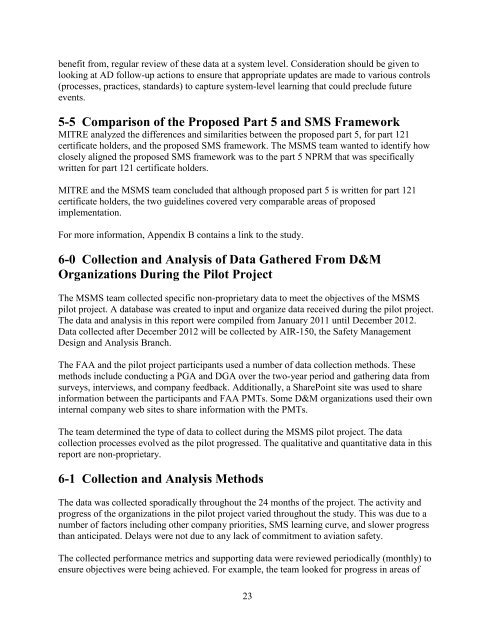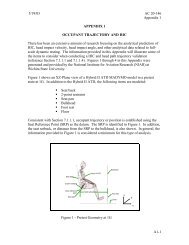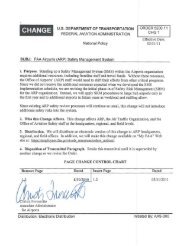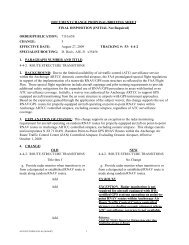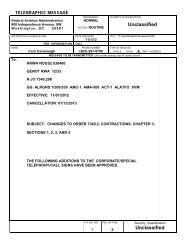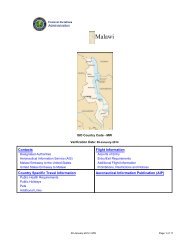2009 SMS Pilot Project (SMSPP) Analysis - FAA
2009 SMS Pilot Project (SMSPP) Analysis - FAA
2009 SMS Pilot Project (SMSPP) Analysis - FAA
Create successful ePaper yourself
Turn your PDF publications into a flip-book with our unique Google optimized e-Paper software.
enefit from, regular review of these data at a system level. Consideration should be given to<br />
looking at AD follow-up actions to ensure that appropriate updates are made to various controls<br />
(processes, practices, standards) to capture system-level learning that could preclude future<br />
events.<br />
5-5 Comparison of the Proposed Part 5 and <strong>SMS</strong> Framework<br />
MITRE analyzed the differences and similarities between the proposed part 5, for part 121<br />
certificate holders, and the proposed <strong>SMS</strong> framework. The M<strong>SMS</strong> team wanted to identify how<br />
closely aligned the proposed <strong>SMS</strong> framework was to the part 5 NPRM that was specifically<br />
written for part 121 certificate holders.<br />
MITRE and the M<strong>SMS</strong> team concluded that although proposed part 5 is written for part 121<br />
certificate holders, the two guidelines covered very comparable areas of proposed<br />
implementation.<br />
For more information, Appendix B contains a link to the study.<br />
6-0 Collection and <strong>Analysis</strong> of Data Gathered From D&M<br />
Organizations During the <strong>Pilot</strong> <strong>Project</strong><br />
The M<strong>SMS</strong> team collected specific non-proprietary data to meet the objectives of the M<strong>SMS</strong><br />
pilot project. A database was created to input and organize data received during the pilot project.<br />
The data and analysis in this report were compiled from January 2011 until December 2012.<br />
Data collected after December 2012 will be collected by AIR-150, the Safety Management<br />
Design and <strong>Analysis</strong> Branch.<br />
The <strong>FAA</strong> and the pilot project participants used a number of data collection methods. These<br />
methods include conducting a PGA and DGA over the two-year period and gathering data from<br />
surveys, interviews, and company feedback. Additionally, a SharePoint site was used to share<br />
information between the participants and <strong>FAA</strong> PMTs. Some D&M organizations used their own<br />
internal company web sites to share information with the PMTs.<br />
The team determined the type of data to collect during the M<strong>SMS</strong> pilot project. The data<br />
collection processes evolved as the pilot progressed. The qualitative and quantitative data in this<br />
report are non-proprietary.<br />
6-1 Collection and <strong>Analysis</strong> Methods<br />
The data was collected sporadically throughout the 24 months of the project. The activity and<br />
progress of the organizations in the pilot project varied throughout the study. This was due to a<br />
number of factors including other company priorities, <strong>SMS</strong> learning curve, and slower progress<br />
than anticipated. Delays were not due to any lack of commitment to aviation safety.<br />
The collected performance metrics and supporting data were reviewed periodically (monthly) to<br />
ensure objectives were being achieved. For example, the team looked for progress in areas of<br />
23


